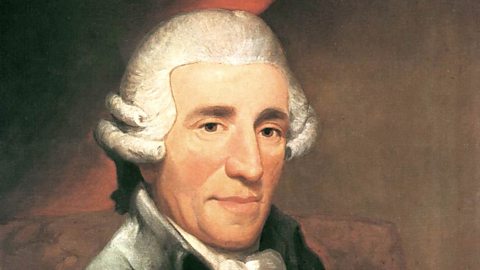Dion Dublin heads to the football pitch to explore Haydn's clever concerto.
Joseph Haydn was an Austrian musician who spent most of his career in the service of an aristocratic family in Hungary but became one of the most famous and well-respected composers of his time. As well as symphonies, string quartets and piano trios, Haydn wrote a vast number of solo piano pieces, songs, choral works, operas and concertos.
One of Haydn's most popular works today is a concerto for trumpet, which he wrote in 1796 for a his good friend, Anton Weidinger, who had invented a new kind of trumpet with five keys, which allowed the instrument to produce more notes of the scale.
Haydn's Concerto for Trumpet in E flat was a ground-breaking addition to the trumpet repertoire, although it is a typical example of a concerto from the Classical period. It has three movements, and uses many of the popular musical conventions of the time, including balance and symmetry.
Listen out for: The Finale, which, like much of Haydn's music, is peppered with good humour and fun!
91Čȱ¬ Philharmonic and soloist Alison Balsom perform Trumpet Concerto (3rd movement).
Joseph Haydn
Haydn is the father of classical music. He invented the sonata, the symphony, the concerto and many of the rules used to create these pieces that composers have followed for hundreds of years. He wrote a lot of music - 104 symphonies, over 20 concertos, 60 piano sonatas and 83 string quartets! He taught both Mozart (the two were great friends) and Beethoven (they didn't get along, Beethoven thought Haydn was 'boring') and he helped both of them in their careers afterwards by telling everyone how great they were. He was a thoroughly nice man!
Haydn's musical life began when he was sent away to boarding school at 6 years old. He left at 16 and began a career as court composer for a series of wealthy families. The richest family in Europe at that time were the Esterhazy's and Haydn worked for them for most of his life, creating music for the best musicians and having the time to experiment and try stuff out. By 1803 he was world famous and had enough money to retire, but with Mozart just behind him and then Beethoven, both of whom added a large helping of personality to Haydn's rules, he is now seen, perhaps unfairly, as the weakest of the three.

MP3s: Listen to or download the music
- Download the
To save to your computer: PC - right-click and save, Mac - ctrl-click and save.
Play Haydn's trumpet melody
Download these MP3s and slideshow for Haydn's famous melody, then play along to the backing track!
To save to your computer: PC - right-click and save, Mac - ctrl-click and save.

Lesson Plans
Download classroom lesson plans to explore Haydn's music.To save to your computer: PC - right-click and save, Mac - ctrl-click and save.
To enable all images to work in the Powerpoint files please save the file to your computer. To save to your computer: PC - right-click and save, Mac - ctrl-click and save.
Primary lesson plans:
Lesson plan by Rachel Leach
Suitable for:
*Key Stage 2 in England and Wales
*Second Level, P5-P7 in Scotland
*Key Stage 1/Key Stage 2 in Northern Ireland
Secondary lesson plans:
Lesson plan 1 written by David Ashworth.
Lesson plan 2 written by Ann Barkway.
Suitable for:
*Key Stage 3 in England, Wales and Northern Ireland
*Third and Fourth Level, S1-S3 in Scotland
Arrangements: Play the piece with simplified parts
All parts have been designed to work together to enable mixed-ability groups to perform together
Beginner/pre-Grade 1
- | | | | |
- | | |
- | |
- | | |
- |
- |
Grade 1-3
- | | |
- | | |
- | |
- | | |
- |
- |
Grade 4-5
- | | | |
- | | |
- | |
- | | |
- |
Combined score
Background information
The Haydn Trumpet Concerto has been arranged for orchestra WITHOUT soloist and is transposed into the key of D major.
Ensembles that wish to play with a solo trumpet may wish to hire original parts as it should be manageable by an orchestra of around grade 5 standard and up.
The original orchestration is:
2.2.0.2 – 2.2.0.0 – tmp, strings